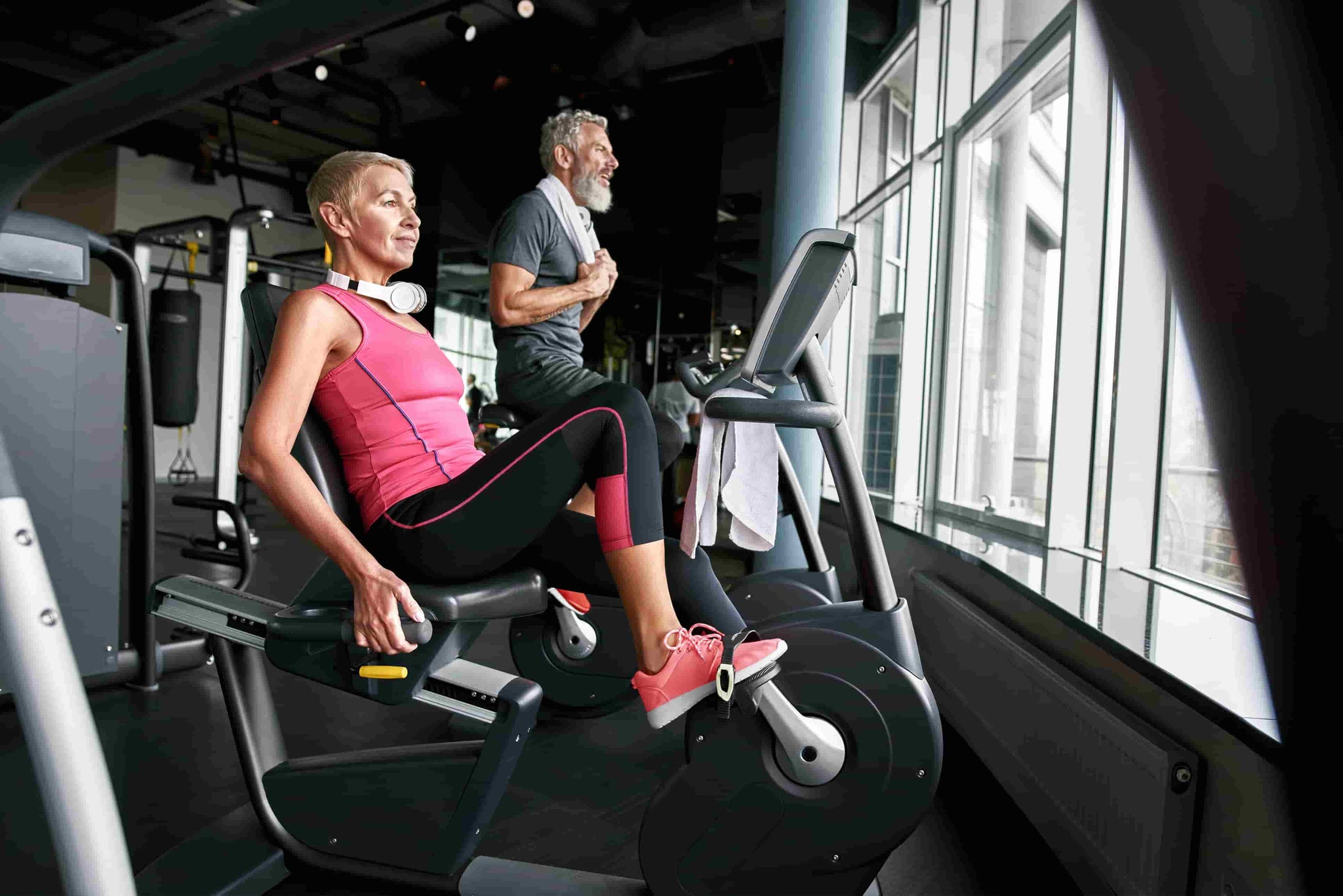Recumbent Bike Weight Loss Benefits: Compared to Other Cardio Options
Written by: Vanswe Fitness
Published on: May 04, 2025. Last updated: May 08, 2025

Compared to treadmills, upright bikes, or elliptical machines, recumbent bikes support weight loss more sustainably — thanks to their low joint impact, superior comfort, and beginner-friendly design. These features help users exercise longer and more consistently, which is crucial for creating a calorie deficit.
When it comes to burning fat, not all cardio machines are created equal. From treadmills to ellipticals to upright bikes, each tool has its pros and cons. But one often overlooked option—the recumbent exercise bike—may offer unique advantages for weight loss, especially for beginners, overweight individuals, and those with joint concerns.
At Vanswe Fitness, we’ve analyzed the numbers and side-by-side comparisons — and turned them into a clear, visual table that shows where recumbent bikes really shine for sustainable weight loss.
Key Benefit #1: Joint-Friendly Fat Burning

Unlike running or upright biking, recumbent bikes provide a low-impact way to burn calories, making them ideal for people with knee, hip, or ankle issues. This joint-friendly design allows users—especially beginners and overweight individuals—to exercise longer without pain, leading to more consistent fat burning over time.
🦵 Impact Comparison:
| Activity | Joint Impact Level |
|---|---|
| Recumbent Bike | ✅ Very Low |
| Running | ❌ High |
| Elliptical | ⚪ Low |
| Upright Bike | ⚪ Medium |
| Walking | ✅ Low |
Tips: According to a 2024 study published in the Journal of Biomechanics [1], semi-recumbent cycling significantly reduces joint contact forces in the knees and hips, making it an ideal low-impact exercise for individuals with arthritis or joint conditions.
(Crossley et al., 2024)
⚠️ Not seeing results from your recumbent bike routine? This article explains Why You Might Not Be Losing Weight and what to do about it.
Key Benefit #2: Better Comfort = Longer Workout Duration

Recumbent bikes are among the most comfortable cardio machines, thanks to their large seat, full back support, and reclined position. This ergonomic setup reduces fatigue and discomfort, allowing users to ride for 45–60 minutes with ease—far longer than most can tolerate on upright bikes or treadmills. The result? More calories burned per session and better weight loss outcomes over time.
Average Duration Per Session by Cardio Type
We analyzed extensive data from fitness apps to provide our readers with clear insights into the average workout durations across popular cardio machines.
| Cardio Equipment | Typical Duration | Notes |
|---|---|---|
| Recumbent Bike | ✅ 45–60 minutes | High comfort allows longer sessions |
| Upright Bike | ⚠ 20–40 minutes | Back strain and saddle discomfort limit time |
| Treadmill (Running) | ❌ 15–30 minutes | High impact often leads to fatigue or joint pain |
| Elliptical | ⚪ 30–45 minutes | Moderate comfort, but upper-body fatigue possible |
| Walking | ✅ 30–60+ minutes | Low intensity; suitable for extended sessions |
Tips: According to a study by Romijn et al. (1993) [2], fat burning is maximized during moderate-intensity, longer-duration exercise—highlighting why steady-state cardio like Zone 2 training is effective for burning fat.
(Romijn et al., 1993)
Key Benefit #3: Easier to Build Consistency

Consistency is key to effective weight loss, and recumbent bikes remove many barriers that prevent regular exercise. With their low-impact design, comfortable seating, and ease of use, users are more likely to ride frequently—even daily. This makes it easier to build a lasting routine, which is essential for creating a long-term calorie deficit and achieving sustainable fat loss.
👌 Beginner-Friendly Aspects:
- Easy to get on/off
- Simple to operate (no balance needed)
- Can be used while watching TV or playing on your phone
- Requires no athletic skill or coordination
🔄 Need a plan that matches your fitness level? Check out our Recumbent Bike Workout Plan to find the right structure for you.
Key Benefit #4: Optimized for Zone 2 Fat-Burning Training

Zone 2 cardio—exercising at 60–70% of your max heart rate—is one of the most effective ways to burn fat. Recumbent bikes are perfectly suited for Zone 2 training, offering a steady, low-impact workout that’s easy to maintain for 30–60 minutes. This makes them an excellent tool for maximizing fat loss through consistent, heart rate-targeted sessions.
Here is the comparison table we’ve prepared for you:
| Exercise Type | Zone 2 Compatibility | Notes |
|---|---|---|
| Recumbent Bike | ✅ Excellent | Stable, easy to monitor heart rate |
| Running | ❌ Hard to maintain | Often pushes into higher heart rate zones |
| Elliptical | ⚪ Variable | May fluctuate with resistance and motion |
| Walking | ❌ Too low | May not elevate heart rate enough |
Tips: The American Heart Association (AHA) [3] states that moderate-intensity aerobic activity corresponds to 60–70% of your maximum heart rate, which is typically calculated as 220 minus your age.
➡️ Want to calculate how many calories you’re actually burning on a recumbent bike? Try our Recumbent Bike Calories Burned Calculator for personalized estimates based on your age, weight, and heart rate.
Key Benefit #5: Best Option for Overweight

For those who are new to exercise, recovering from injury, or carrying extra weight, recumbent bikes offer unmatched safety and accessibility. With a low step-through design, full back support, and zero-impact pedaling, they reduce the risk of strain while making workouts more approachable. This makes recumbent bikes the top choice for building confidence, consistency, and long-term weight loss success.
Here is the comparison table we’ve prepared for you:
| Equipment / Exercise | Rehab-Friendly? | Type of Rehab It Supports |
|---|---|---|
| Recumbent Bike | ✅ Excellent | Knee rehab, hip arthritis, lower back pain, post-surgery recovery |
| Upright Bike | ⚠ Moderate | General cardio rehab, low back strain (with caution) |
| Treadmill (Walking) | ⚠ With Caution | Mild joint rehab, cardiovascular reconditioning |
| Treadmill (Running) | ❌ Not Recommended | Not suitable for injury rehab due to high impact |
| Elliptical | ⚠ Moderate | Cardiovascular rehab, early-stage knee rehab (with supervision) |
| Rowing Machine | ❌ Not Ideal | Generally not recommended; strains lower back and knees |
| Walking (Outdoor) | ⚪ Depends | Light rehab for balance training and mild joint issues |
Tips: The American College of Sports Medicine (ACSM) [4] recommends recumbent cycling as a safe, effective exercise for obese and elderly populations, especially in rehabilitation contexts.
💡 Looking for pain-free cardio or recovering from injury? See how recumbent bikes support joint recovery and comfort in our Expert Rehab Guide.
Conclusion
While recumbent bikes may not burn the most calories per minute, they offer superior sustainability, safety, and comfort—key elements for effective long-term weight loss.
If you're serious about fat loss and want a machine that encourages daily use without hurting your joints, the recumbent bike is a smart, research-backed choice.
ℹ️ Want a full breakdown of recumbent bike benefits beyond weight loss? Explore our complete list of Recumbent Bike Benefits.
FAQs
Is a Recumbent Bike Good for Weight Loss?
Yes, a recumbent bike will help you to lose weight effectively. It helps burn calories, protects your joints, and supports consistent workouts—all key to long-term fat loss. Its comfortable, low-impact design makes it easier to stick with a routine, especially for beginners or those with joint issues. Depending on your age, gender, weight and workout intensity, you can easily calculate your calories burned on a recumbent bike.
Reference:
- Crossley, C. B., Diamond, L. E., Saxby, D. J., de Sousa, A., Lloyd, D. G., Che Fornusek, & Pizzolato, C. (2024). Joint contact forces during semi-recumbent seated cycling. Journal of biomechanics, 168, 112094. https://doi.org/10.1016/j.jbiomech.2024.112094
- Romijn, J. A., Coyle, E. F., Sidossis, L. S., Gastaldelli, A., Horowitz, J. F., Endert, E., & Wolfe, R. R. (1993). Regulation of endogenous fat and carbohydrate metabolism in relation to exercise intensity and duration. The American journal of physiology, 265(3 Pt 1), E380–E391. https://doi.org/10.1152/ajpendo.1993.265.3.E380
- American Heart Association. (2021). Target heart rates chart. Retrieved from https://www.heart.org/en/healthy-living/fitness/fitness-basics/target-heart-rates
- American College of Sports Medicine. (2021). ACSM’s guidelines for exercise testing and prescription (12th ed.). Philadelphia, PA: Wolters Kluwer.
Latest Articles





